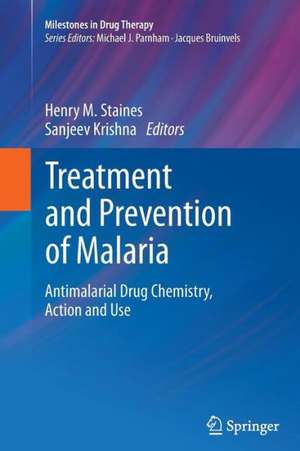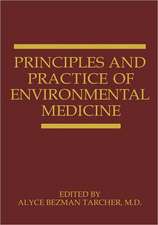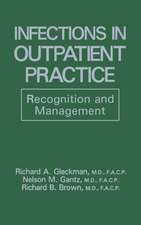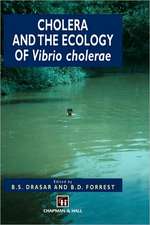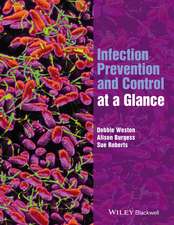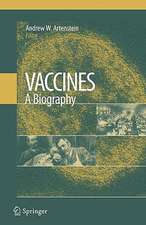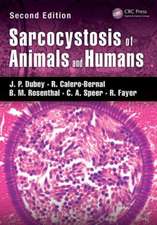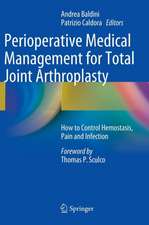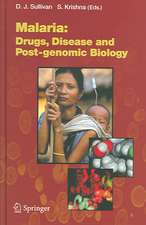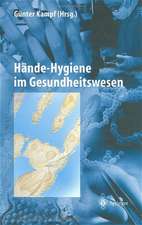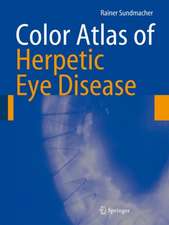Treatment and Prevention of Malaria: Antimalarial Drug Chemistry, Action and Use: Milestones in Drug Therapy
Editat de Henry M. Staines, Sanjeev Krishnaen Limba Engleză Paperback – 22 feb 2014
Starting with an overview of the disease and its current political, financial and technical context, this Milestones in Drug Therapy volume describes the history, chemistry, mechanisms of action and resistance, preclinical and clinical use, pharmacokinetics and safety and tolerability of the current range of antimalarial drugs. There is particular emphasis on artemisinins and related peroxides, as these drugs have now become the frontline treatment for malaria. Next generation antimalarials, molecular markers for detecting resistance, the importance of diagnostics and disease prevention are also covered in detail.
| Toate formatele și edițiile | Preț | Express |
|---|---|---|
| Paperback (1) | 1095.90 lei 6-8 săpt. | |
| Springer – 22 feb 2014 | 1095.90 lei 6-8 săpt. | |
| Hardback (1) | 1100.64 lei 6-8 săpt. | |
| Springer – 6 ian 2012 | 1100.64 lei 6-8 săpt. |
Din seria Milestones in Drug Therapy
- 5%
 Preț: 1409.69 lei
Preț: 1409.69 lei - 5%
 Preț: 365.46 lei
Preț: 365.46 lei - 5%
 Preț: 371.83 lei
Preț: 371.83 lei - 5%
 Preț: 711.52 lei
Preț: 711.52 lei - 5%
 Preț: 721.77 lei
Preț: 721.77 lei - 5%
 Preț: 649.11 lei
Preț: 649.11 lei - 5%
 Preț: 1103.03 lei
Preț: 1103.03 lei - 5%
 Preț: 1407.30 lei
Preț: 1407.30 lei - 5%
 Preț: 667.36 lei
Preț: 667.36 lei - 5%
 Preț: 364.53 lei
Preț: 364.53 lei - 5%
 Preț: 1093.52 lei
Preț: 1093.52 lei - 5%
 Preț: 361.06 lei
Preț: 361.06 lei - 5%
 Preț: 708.58 lei
Preț: 708.58 lei - 5%
 Preț: 365.10 lei
Preț: 365.10 lei - 5%
 Preț: 1099.35 lei
Preț: 1099.35 lei - 5%
 Preț: 1097.18 lei
Preț: 1097.18 lei - 5%
 Preț: 1284.08 lei
Preț: 1284.08 lei - 5%
 Preț: 641.46 lei
Preț: 641.46 lei - 5%
 Preț: 1100.64 lei
Preț: 1100.64 lei - 5%
 Preț: 1606.80 lei
Preț: 1606.80 lei - 5%
 Preț: 1425.76 lei
Preț: 1425.76 lei - 5%
 Preț: 671.70 lei
Preț: 671.70 lei - 5%
 Preț: 710.23 lei
Preț: 710.23 lei - 5%
 Preț: 1801.57 lei
Preț: 1801.57 lei - 5%
 Preț: 1100.30 lei
Preț: 1100.30 lei - 5%
 Preț: 1416.66 lei
Preț: 1416.66 lei - 5%
 Preț: 1092.58 lei
Preț: 1092.58 lei - 5%
 Preț: 716.65 lei
Preț: 716.65 lei - 5%
 Preț: 718.82 lei
Preț: 718.82 lei - 5%
 Preț: 715.35 lei
Preț: 715.35 lei - 5%
 Preț: 1084.72 lei
Preț: 1084.72 lei - 5%
 Preț: 1092.22 lei
Preț: 1092.22 lei - 5%
 Preț: 1092.99 lei
Preț: 1092.99 lei - 5%
 Preț: 1103.39 lei
Preț: 1103.39 lei - 5%
 Preț: 1100.85 lei
Preț: 1100.85 lei - 5%
 Preț: 1285.88 lei
Preț: 1285.88 lei
Preț: 1095.90 lei
Preț vechi: 1153.57 lei
-5% Nou
Puncte Express: 1644
Preț estimativ în valută:
209.73€ • 218.15$ • 173.14£
209.73€ • 218.15$ • 173.14£
Carte tipărită la comandă
Livrare economică 14-28 aprilie
Preluare comenzi: 021 569.72.76
Specificații
ISBN-13: 9783034808088
ISBN-10: 3034808089
Pagini: 328
Ilustrații: X, 318 p.
Dimensiuni: 155 x 235 x 17 mm
Greutate: 0.46 kg
Ediția:2012
Editura: Springer
Colecția Springer
Seria Milestones in Drug Therapy
Locul publicării:Basel, Switzerland
ISBN-10: 3034808089
Pagini: 328
Ilustrații: X, 318 p.
Dimensiuni: 155 x 235 x 17 mm
Greutate: 0.46 kg
Ediția:2012
Editura: Springer
Colecția Springer
Seria Milestones in Drug Therapy
Locul publicării:Basel, Switzerland
Public țintă
ResearchCuprins
Antimalarial drugs and the control and elimination of malaria.- 4-Aminoquinolines: chloroquine, amodiaquine and next generation analogues.- Cinchona alkaloids: quinine and quinidine.- 8-Aminoquinolines: primaquine and tafenoquine.- Other 4-methanolquinolines, amyl alcohols and phentathrenes: mefloquine, lumefantrine, halofantrine, piperaquine and pyronaridine.- Antifolates: pyrimethamine, proguanil, sulphadoxine and dapsone.- Naphthoquinones: atovaquone, and other antimalarials targeting mitochondrial functions.- Non-antifolate antibiotics: clindamycin, doxycycline, azithromycin and fosmidomycin.- Artemisinins: artemisinin, dihydroartemisinin, artemether, arteether and artesunate.- Second generation peroxides: the OZs and artemisone.- Combination therapy in light of emerging artemisinin resistance.- New medicines to combat malaria: an overview of the global pipeline of therapeutics.- Molecular markers of Plasmodium resistance to antimalarials.- Prevention of malaria.- Malaria diagnostics: lighting the path.
Recenzii
From the reviews:
“Staines and Krishna successfully captures the essence of what we know about antimalarials at the beginning of the second decade of the 21st century. … the book is a welcome and highly valuable documentation on where we stand and offers valuable food for thought in the search for the way forward.” (Martin P. Grobusch, Trends in Parasitology, September, 2012)
“Staines and Krishna successfully captures the essence of what we know about antimalarials at the beginning of the second decade of the 21st century. … the book is a welcome and highly valuable documentation on where we stand and offers valuable food for thought in the search for the way forward.” (Martin P. Grobusch, Trends in Parasitology, September, 2012)
Textul de pe ultima copertă
Malaria has defeated previous efforts at eradication and remains a massive global public health problem despite being readily preventable and treatable. It is a devastating disease that also extracts huge economic costs from the poorest countries in endemic regions.
Starting with an overview of the disease and its current political, financial and technical context, this Milestones in Drug Therapy volume describes the history, chemistry, mechanisms of action and resistance, preclinical and clinical use, pharmacokinetics and safety and tolerability of the current range of antimalarial drugs. There is particular emphasis on artemisinins and related peroxides, as these drugs have now become the frontline treatment for malaria. Next generation antimalarials, molecular markers for detecting resistance, the importance of diagnostics and disease prevention are also covered in detail.
Starting with an overview of the disease and its current political, financial and technical context, this Milestones in Drug Therapy volume describes the history, chemistry, mechanisms of action and resistance, preclinical and clinical use, pharmacokinetics and safety and tolerability of the current range of antimalarial drugs. There is particular emphasis on artemisinins and related peroxides, as these drugs have now become the frontline treatment for malaria. Next generation antimalarials, molecular markers for detecting resistance, the importance of diagnostics and disease prevention are also covered in detail.
Caracteristici
Gives a comprehensive account of the recent advances in anti-malaria drugs Chapters contributed by expert authors Describes new ideas and directions for study Includes supplementary material: sn.pub/extras
